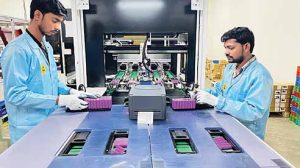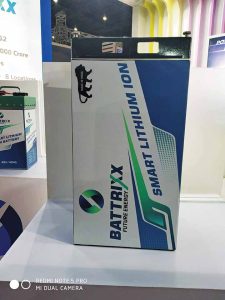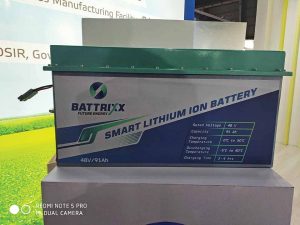Battery performance relies on the perfect chemistry tasked with the job. Deepti Thore with inputs from Ashish Bhatia finds out from Team Battrix if they have zeroed in, yet.
 Battrix first made waves at the Auto Expo 2020 as a ‘Made In India’ validated product. The future technologies division Kabra Extrusiontechnik Ltd.( of the Kolsite Group) back then showcased the ‘Smart Lithium Ion Battery Pack’ in different configurations including a 48V/91 Ah specification with a charging time of three to four hours. Its 60V/26 Ah battery pack came with a similar configuration and the company topped it with a 72V/50 Ah battery pack that came along with a fast charging time of zero to two hours. Fast forward to 2022 and besides lithium-ion battery packs with some interesting features as an early adopter, the company has since forayed into modules for e-vehicles, and Battery Management Systems (BMS). The journey that commenced in 2017 had the company lay a strong foundation with technical collaborations like the one with European company Unicor GmbH (Germany) in addition to the one with Mecanor Oy (Finland) to leverage the latter’s patented design and manufacturing process. Speaking about the early mover advantage, Anand Kabra, Managing Director, Battrixx, commented, “We didn’t have a very clear idea of who our customers would be. But just the belief that the whole e-mobility space is going to turn around and it’s going to be the future drove us.”
Battrix first made waves at the Auto Expo 2020 as a ‘Made In India’ validated product. The future technologies division Kabra Extrusiontechnik Ltd.( of the Kolsite Group) back then showcased the ‘Smart Lithium Ion Battery Pack’ in different configurations including a 48V/91 Ah specification with a charging time of three to four hours. Its 60V/26 Ah battery pack came with a similar configuration and the company topped it with a 72V/50 Ah battery pack that came along with a fast charging time of zero to two hours. Fast forward to 2022 and besides lithium-ion battery packs with some interesting features as an early adopter, the company has since forayed into modules for e-vehicles, and Battery Management Systems (BMS). The journey that commenced in 2017 had the company lay a strong foundation with technical collaborations like the one with European company Unicor GmbH (Germany) in addition to the one with Mecanor Oy (Finland) to leverage the latter’s patented design and manufacturing process. Speaking about the early mover advantage, Anand Kabra, Managing Director, Battrixx, commented, “We didn’t have a very clear idea of who our customers would be. But just the belief that the whole e-mobility space is going to turn around and it’s going to be the future drove us.”
Making chemistry work
Battrixx’s state-of-the-art facility at Chakan, in Pune is home to highly-skilled and experienced R&D, validation and testing teams, driven by industry best practices as per Kabra. The design, development and production of Battrixx products is undertaken here and part of the responsibilities is the focus on zeroing in on future chemistries. The facility not only works on future chemistries but also technical projects as a whole. Getting maximum traction from the two-wheeler segment, the company is also gearing up for a foray in the fast growing three-wheeler segment. Kabra highlighted, “We work with five out of the top two-wheeler OEMs in the country today with possibly 50 per cent share of their business or more.” With the necessary equipment for battery certification installed, the company is driving the industry to learn and adopt newer means of ensuring consumer safety deemed as quintessential.
 With the recent spurt in battery fires allegedly out of overnight charging, Kabra stressed on the importance of getting the lithium-ion battery chemistry right. “In terms of lithium, the current chemistry involves Nickel-Manganese-Cobalt (NMC). There is always a safety risk over there because of cobalt being in the chemistry,” he cited. Referring to the spurt in fire incidents as an example, he explained that there are multiple safety checks and redundancies being built in. Speaking of the localisation levels of these battery packs, Kabra mentioned that except for the cell everything has been locally manufactured. This is validated by the ‘Make In India’ badge on the battery pack. The company aims at 100 per cent localisation levels of BMS as well as other components going forward. It is banking on a portfolio that includes battery pack models for two-wheelers, three-wheelers, four-wheelers and even a bus battery.
With the recent spurt in battery fires allegedly out of overnight charging, Kabra stressed on the importance of getting the lithium-ion battery chemistry right. “In terms of lithium, the current chemistry involves Nickel-Manganese-Cobalt (NMC). There is always a safety risk over there because of cobalt being in the chemistry,” he cited. Referring to the spurt in fire incidents as an example, he explained that there are multiple safety checks and redundancies being built in. Speaking of the localisation levels of these battery packs, Kabra mentioned that except for the cell everything has been locally manufactured. This is validated by the ‘Make In India’ badge on the battery pack. The company aims at 100 per cent localisation levels of BMS as well as other components going forward. It is banking on a portfolio that includes battery pack models for two-wheelers, three-wheelers, four-wheelers and even a bus battery.
Overcoming Challenges
 Known to have acquired land for its Chakan plant in 2019, the full commercial production commenced in March 2020. Being the Covid19 marred fiscal, the company was faced with many challenges on the supply side. Be it the fluctuation of freight rates in August 2021 which went overboard or the commodity price hikes including the rising cell prices that resulted in battery prices shooting up. Making hay of the opportunities in times of adversity, the company developed multiple prototypes with a lot of OEMs. Kabra stated, “We started building on the prototypes in the new facility and the year 2021-22 was the first real year of production for us and ever since it’s been a phenomenal growth journey for us.” Kabra opined that the world demand for EVs is on an all time high auguring well for Battrix. “The capacities still have to catch up. So there is actually a very high need for good cells in the market. At some point there has been a demand supply gap as well on the supplies of cells, but we’ve been able to address it though for a good long term,” he added. In terms of BMS too, the company dealt with challenges on the supply side due to the semiconductor shortages. “That was especially due to the drop of vehicle sales and unavailability of certain components but we more or less overcame it,” he asserted. Mentioning that Russia supplies 20 per cent of the world’s nickel, Kabra admitted to it impacting the supply chain. To make the Battery Management System (BMS) safe, reliable and enduring operation of any battery-powered application, the company boasts of customisation capabilities in its BMS. Battrixx aims at involving the customer at every stage for modifying its existing BMS designs with proprietary algorithms to perfectly align with the latter’s design needs. According to Kabra, BMS is the form of communication between the charger and the battery to control the amount of current which is coming in. “You want to control the charging profile which is there but that can happen when both the BMS and the chargers communicate. So this is a very standard feature, although we are yet to see a mass adoption,” he opined. To meet ever-evolving customer demands, Battrixx constantly upgrades or acquires new technology, powered by a state-of-the-art in-house R&D centre in Pune. Presently, Battrixx’s infrastructure can handle both cylindrical and prismatic cells to manufacture modules and packs with in-house built advanced Battery Management System (BMS) integration.
Known to have acquired land for its Chakan plant in 2019, the full commercial production commenced in March 2020. Being the Covid19 marred fiscal, the company was faced with many challenges on the supply side. Be it the fluctuation of freight rates in August 2021 which went overboard or the commodity price hikes including the rising cell prices that resulted in battery prices shooting up. Making hay of the opportunities in times of adversity, the company developed multiple prototypes with a lot of OEMs. Kabra stated, “We started building on the prototypes in the new facility and the year 2021-22 was the first real year of production for us and ever since it’s been a phenomenal growth journey for us.” Kabra opined that the world demand for EVs is on an all time high auguring well for Battrix. “The capacities still have to catch up. So there is actually a very high need for good cells in the market. At some point there has been a demand supply gap as well on the supplies of cells, but we’ve been able to address it though for a good long term,” he added. In terms of BMS too, the company dealt with challenges on the supply side due to the semiconductor shortages. “That was especially due to the drop of vehicle sales and unavailability of certain components but we more or less overcame it,” he asserted. Mentioning that Russia supplies 20 per cent of the world’s nickel, Kabra admitted to it impacting the supply chain. To make the Battery Management System (BMS) safe, reliable and enduring operation of any battery-powered application, the company boasts of customisation capabilities in its BMS. Battrixx aims at involving the customer at every stage for modifying its existing BMS designs with proprietary algorithms to perfectly align with the latter’s design needs. According to Kabra, BMS is the form of communication between the charger and the battery to control the amount of current which is coming in. “You want to control the charging profile which is there but that can happen when both the BMS and the chargers communicate. So this is a very standard feature, although we are yet to see a mass adoption,” he opined. To meet ever-evolving customer demands, Battrixx constantly upgrades or acquires new technology, powered by a state-of-the-art in-house R&D centre in Pune. Presently, Battrixx’s infrastructure can handle both cylindrical and prismatic cells to manufacture modules and packs with in-house built advanced Battery Management System (BMS) integration.
Building an ecosystem
 Battrixx is also offering battery swapping stations for three-wheelers and bulk chargers along with complete end-to-end software applications including a mobile app. to help end-users locate the nearest charging station. There is an in-built payment gateway on offer as well. Battrixx is participating in the infrastructure space through IoT devices, software and service in addition. “For example, if you’re a fleet operator, you want to know the utilisation of your assets, which asset is going to get utilised to predict the life of the battery and predict the life of the vehicle through intelligent analytic. We will facilitate it,” Kabra informed.
Battrixx is also offering battery swapping stations for three-wheelers and bulk chargers along with complete end-to-end software applications including a mobile app. to help end-users locate the nearest charging station. There is an in-built payment gateway on offer as well. Battrixx is participating in the infrastructure space through IoT devices, software and service in addition. “For example, if you’re a fleet operator, you want to know the utilisation of your assets, which asset is going to get utilised to predict the life of the battery and predict the life of the vehicle through intelligent analytic. We will facilitate it,” Kabra informed.
The outlay
In December 2021, Kabra Extrusiontechnik announced a capital raise of Rs.301 crore through a mix of equity and debt. The funds were earmarked to ramp up its initial capacity of 0.5 GWh annually. Witnessing a lot of traction on the swapping side, in February 2022, the company acquired Varos Technology Pvt. Ltd. of Pune specialised in electronics and electrical related to the whole battery swapping systems with multiple devices like IoT devices, or devices like battery control unit, vehicle control unit, chargers, and charging station control unit. “They are also very strong on data analytic, machine learning. In terms of the three-wheelers segment, the company is adding a fully automatic line in August this year,” Kabra revealed. The company is also working on the high voltage segment in the Light Commercial Vehicles (LCV) segment expected to take off in 2023.
——————————————————
Battrixx BMS Features:
- Robust SOC, cell balancing and SOH estimation algorithms
- Communication: CAN, RS 485, RS 232, IOT (Bluetooth, GPS)
- Communication for efficient charging
- Safety protections in line with AIS 004, AIS 048, CISPR, ASIL D
- Over / Under Voltage protection
- Over temperature protection during charge / discharge / regen
- Under temperature protection during charge / discharge / regen
- Over-current protection during charge / discharge / regen
- Level I up to one minute sustaining capacity
- Level II up to 20 second sustaining capacity
- Short circuit protection












Leave a Reply